New preliminary plans have been revealed for a twenty-unit project at 11511 Summit Wood Road in Los Altos Hills, Santa Clara County. The residential proposal is the first seen in the Bay Area to use the highly anticipated Builder’s Remedy, a Zoning Holiday provision enforced by the State for cities with non-compliant housing elements. Sasha Zbrozek is the property owner and applicant.
The 1.84-acre property is located in Los Altos Hills, an incorporated town of 8,489 people during the 2020 Census. The city’s notable residents include several billionaires, athletes, and prominent Silicon Valley elite. As far as YIMBY can see, the low-slung residential proposal could become the largest single residential building in Los Altos Hills, just north of Black Mountain and close to Palo Alto, Mountain View, Sunnyvale, and Cupertino. The town, including the existing lot of 11511 Summit Wood Road, is dominated by single-family housing.
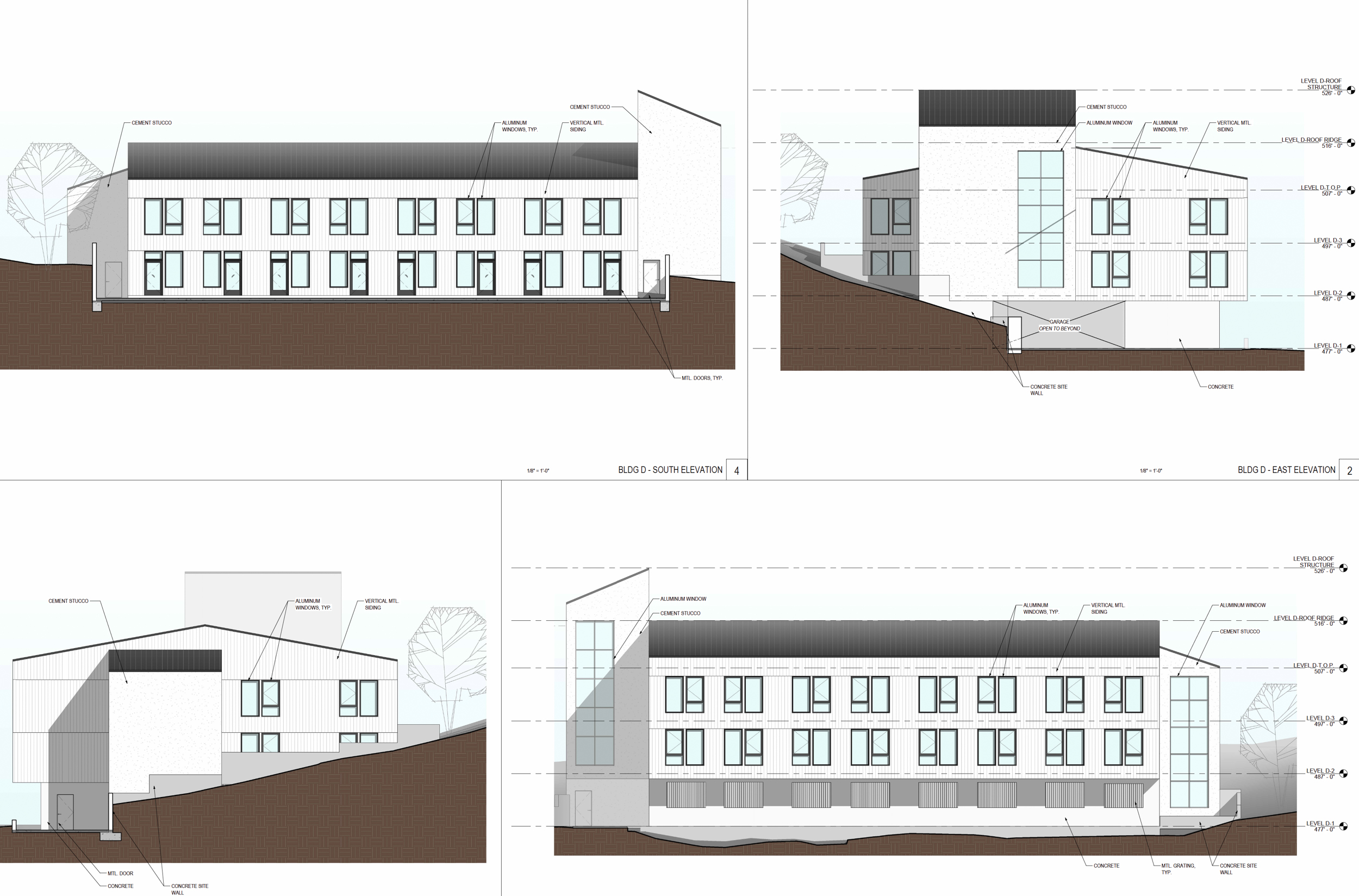
11511 Summit Wood Road apartments facade elevation, rendering by OpenScope Studio
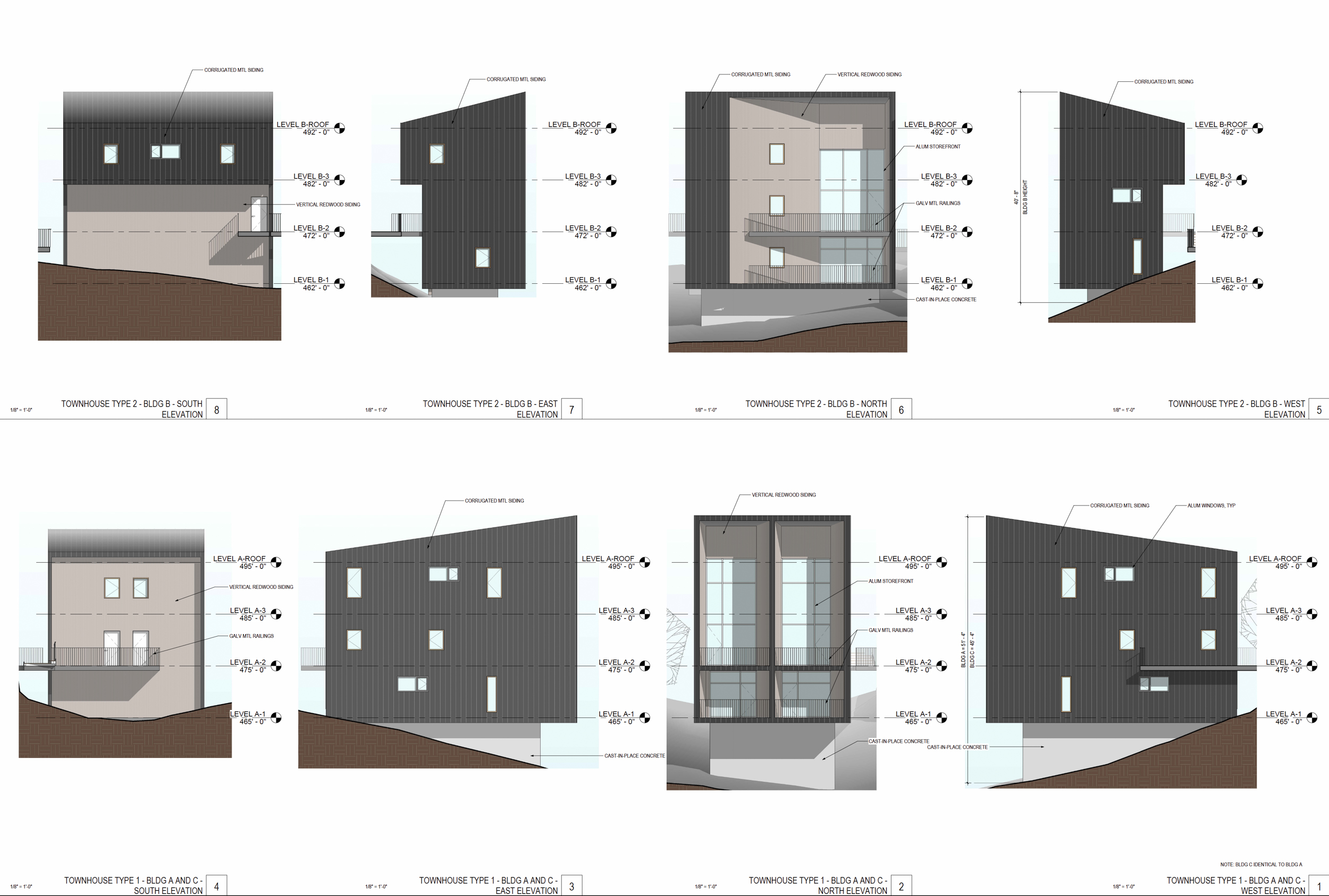
11511 Summit Wood Road duplexes facade elevation, rendering by OpenScope Studio
Initial plans for 11511 Summit Wood yield around 32,700 square feet of total floor area, with 10,450 square feet in the five townhouse-style units and 12,410 square feet for the 15-unit building, all units spanning around 815 square feet. All residents will have access to an 815-square-foot amenity space on level two of the larger structure. Four units will be designated as affordable housing for low-income residences.
There will be two three-story duplexes and one three-story single-family home. Protected parking for 28 cars will be included, with eight exposed spots and 20 covered spots. The vehicular capacity is far below the city’s required zoning for 80 spaces. Bicycle parking is not specified. The existing pool and driveway will be retained throughout the development.
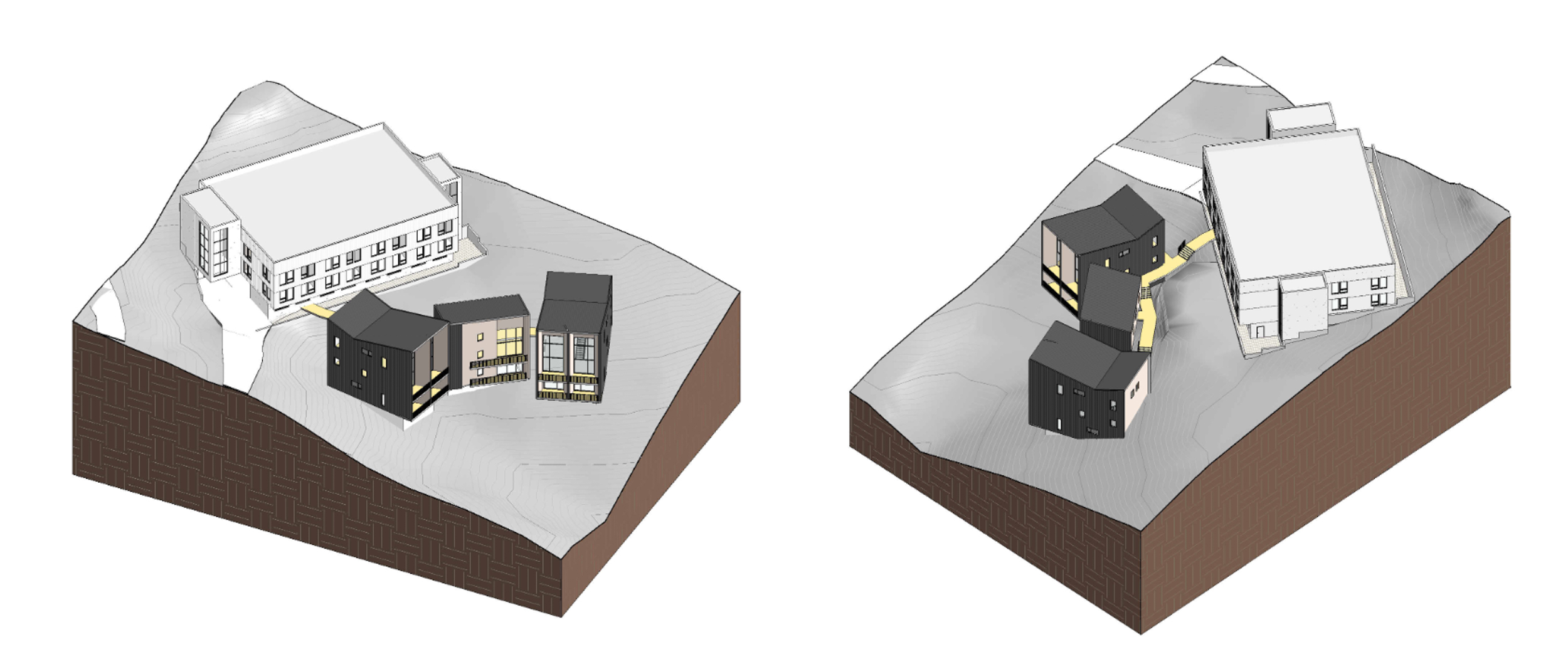
11511 Summit Wood Road cross sections, design by OpenScope Studio
OpenScope Studio is the project architect. Illustrations provided in the plan set are preliminary, with the design, layout, and facade materials liable to change as the project moves forward. The project design is intentionally simple to save costs. Facade materials include corrugated metal siding. The apartment complex will be covered with cement stucco, while vertical Redwood panels will add warmth and character to both townhome duplexes and the single-family home.
Speaking with Sarah Klearman of the San Francisco Business Times, the project architect Mark Hogan had hinted at plans for Los Altos Hills, describing the then-unknown project applicant as “someone with a large lot which feels like we should be building alt more housing and wanted to take advantage” of the Remedy.
The project has been made public since the preliminary application was submitted to the Town of Los Altos Hills Planning Department. Within the application, Zbrozek writes that “while the town has adopted its 6th-cycle housing element, I do not believe it is substantially compliant with state law. Due to the failure to adopt a substantially-compliant element by the statutory deadline, the town is barred from denying housing development projects such as this on the basis of noncompliance with zoning or the general plan.”
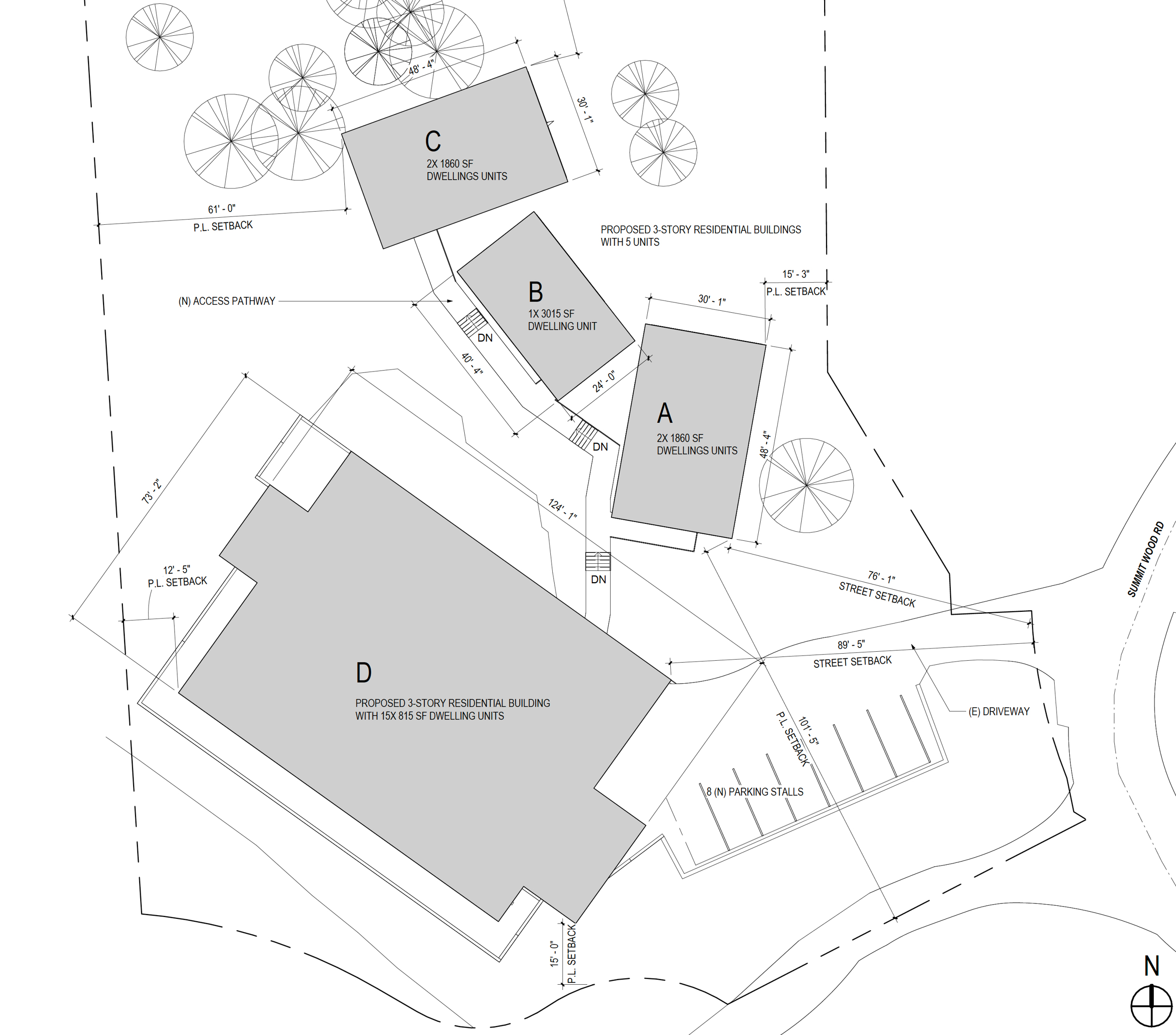
11511 Summit Wood Road site map, illustration by OpenScope Studio
While the project appears compliant and suitable for protection via the Builder’s Remedy, Zbrozek has shared with YIMBY an opinion shared with many, writing, “timelines are enormously unclear since it’s likely litigation will be required to establish the entitlements.” The developer hazards to guess construction will take at least five years to start.
Along with the 20-unit plans, Zbrozek has submitted a five-unit version with the two duplex buildings and single-family residences.
The Builder’s Remedy is a provision first put into state law over two decades ago in the Housing Accountability Act. Recent state laws have galvanized strength around the provision, and now dozens of cities across the Bay Area will see its consequences.
The Builder’s Remedy will impact cities after the Housing Element is deemed non-compliant with the state’s housing law. The remedy removes all local zoning control from the city, though applications must still comply with the California Environmental Quality Act, i.e., CEQA. All Remedy applications must designate 20% of units as affordable, or all units must be affordable for moderate-income households.
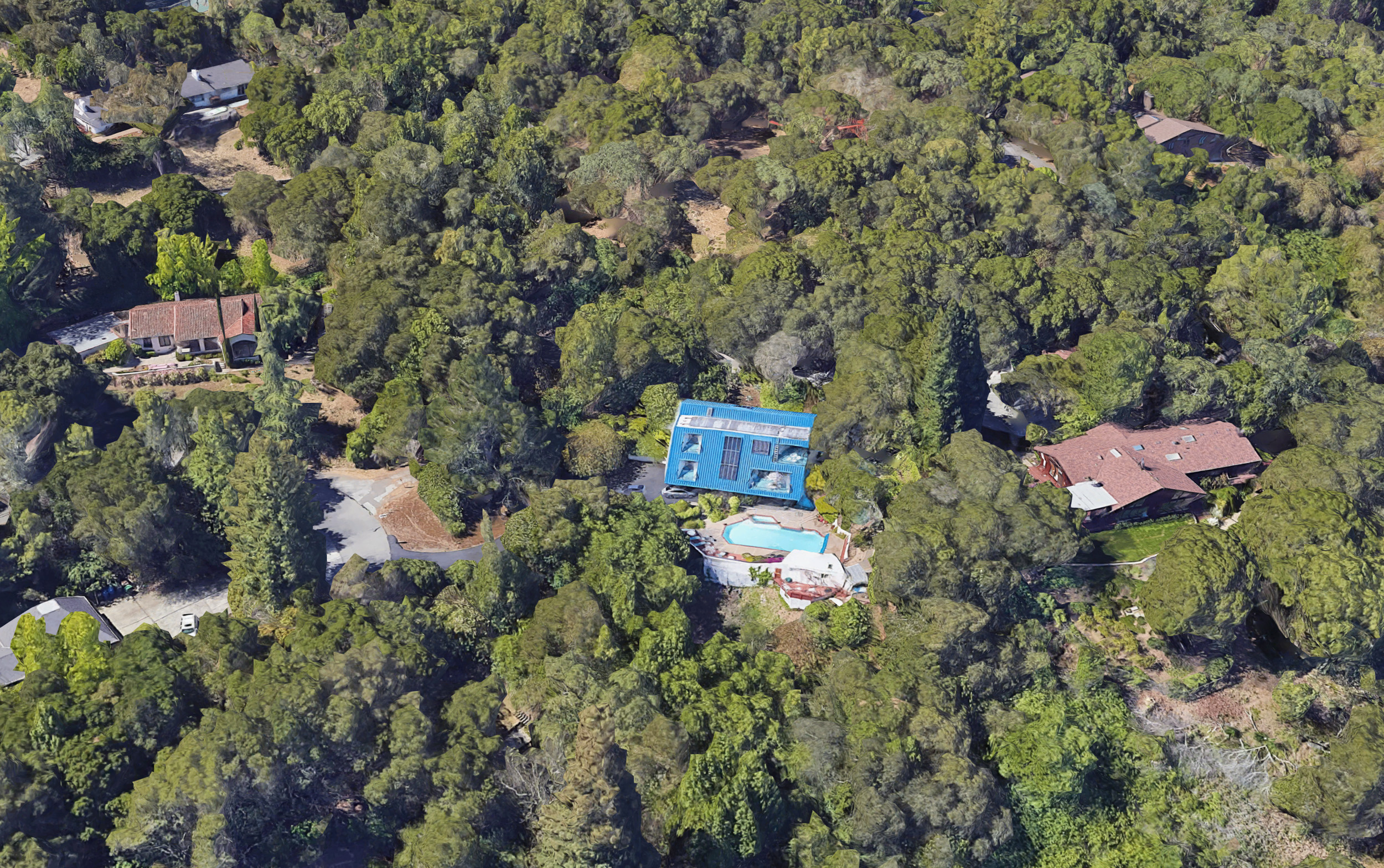
11511 Summit Wood Road, image via Google Satellite
For more information about the Builder’s Remedy, see the recent article by Sarah Klearman of the San Francisco Business Times, and visit the YIMBY Law website for details about how to utilize the provision.
Subscribe to YIMBY’s daily e-mail
Follow YIMBYgram for real-time photo updates
Like YIMBY on Facebook
Follow YIMBY’s Twitter for the latest in YIMBYnews

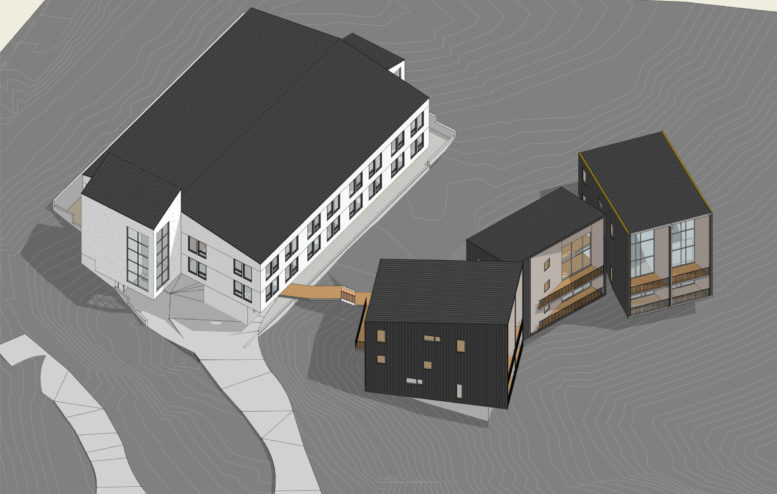
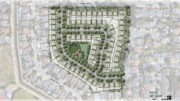
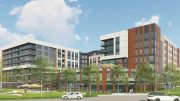
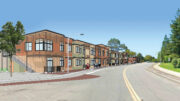
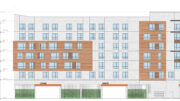
The designs look great, but having lived in Los Altos I am skeptical it will happen. They have really strict laws around building there. For example each lot needs to be no less than 1 acre.
That’s the whole point of the builders remedy. It allows developers to bypass any local zoning restrictions
It seems to to be very risky to place all those units around those very expensive single family homes. Won’t the neighbors sue the developer?
Sue for what? It’s completely legal. They would lose in court.
the california constitution should not be below these homeowners/”NEIGHBORS” just because they have more money than you and me…
As an individual property owner, you have very little direct control over what your neighbors do on their property. [As an aside, this is one reason some people like HOAs.] Typically when you hear about people suing about projects (in California) they are suing the city (or other local government agency) for approving something that the plaintiff believes violates existing laws/regulations/policies (and therefore shouldn’t have been approved in the first place). Since typically there are a lot of detailed requirements and discretion typically involved in approving projects, there are lots of things to potentially find fault with.
Here the government has zero discretion about approving this project (contingent on the outcome of the inevitable lawsuit between the developer and the city), leaving little to nothing for a neighbor to sue the city over.
In that case, they’ll likely try to sue the State.
There is, of course, no case law yet, but a lot of real estate attorneys I’ve talked to believe that “builder’s remedy,” along with the other bills passed over the past few years in Sacramento, would likely override any HOA provisions — as in, if city and county ordinances are negated, contracts between private parties would likely not have much chance. There are many interested parties that are likely to attempt to have the courts throw this, and other recently enacted housing/zoning/land use statutes, tossed out. Unless there is some huge sudden change in the make-up of the Legislature, along with the Governor, or a State-wide initiative ballot measure (anyone got a few hundred billion they are willing to chance on winning?), this is likely to stand. Right now, the number we’ve seen State-wide has not been large — due to the economy, interest rates, tech layoffs, etc., etc. — may or may not change as conditions change, assuming that conditions may change, which is uncertain as to if, to say nothing about when.
Since Los Altos Hills has already submitted a Housing Element that is substantially compliant with state law, this is a very odd event.
It’s also strange that if the property owner is serious about this project that they would have so little parking since in order to sell or rent these units they will need at least two spaces per unit plus some additional guest parking spaces. Obviously there is no mass transit, either high-quality or low-quality, in this area.
The good thing is that this project either must have 20% of the units as affordable, or they can do 100% of the units as moderate. This is the reason why you haven’t seen large numbers of “Builders Remedy” projects in more normal towns since the BMR requirement is lower, at least for rentals. Developers already complain about 15% BMR being financially impossible, they certainly don’t want to have to do 20% on a project that would have been approved anyway, but in Los Altos Hills this project would never have received normal approval due to minimum lot size requirements and parking requirements. Ironically, Builders Remedy has now increased the value of land in cities like Los Altos Hills.
This looks more like some sort of publicity stunt that the property owner is doing. Especially since they have an alternate plan for a five unit version, presumably with adequate parking.
I hope the development will be built next to big liberals!
I agree with you Brandon! This is a ridiculous project for LAH and another reason why we natives left our disintegrating blue CA for a well
run red. If this can happen in sleepy Los Altos ugh
What did conservatives used to say, “better dead that red? The ends of the political spectrum are closer to each other than the middle.
Odd how much republicans love government overreach when it comes to protecting rights for cars, mandating free parking, and limiting what you can build on your own land. Then they love socialist mandates and subsidies for parking minimums, while restricting building hight and imposing occupancy limits. Big brother knows best for what an owner can (can’t) build on their land.
As a “local native” I say ban free street parking and let owners build this free of government limits or subsidies. Let the market decide if this works. See how many people will choose to live here without cars. I know many who will.
11511 Summitwood is located less than a mile from Foothill College. That’s a 16 minute walk on Google Maps, and it is beautiful, near the Rhus Ridge trail. Moody & Altamont Roads are very popular rides for cyclists, so the proposed homes can be reached by bike.
For ADU’s, Parking requirements “shall not exceed one parking space per unit or
bedroom, whichever is less.” Also, ADUs are exempt from parking requirements when there is a car share vehicle located within one block of the ADU. Both Uber and Lyft pick up on Summitwood. Back in the 1970s, Santa Clara County Transit had a Dial-a-Ride program and county buses went up Tepa Way to take school children home from Saint Nicholas School. The town could reasonably limit on-street parking on narrow or winding areas of the street, to maintain access for fire trucks and ambulances, so parking does not have to be a burden to the neighborhood.
SummitWood cannot take the traffic. I would again propose to anyone drove the road from Tepa. Semi trucks cannot negotiate the turn at my house without backing and negotiating the turn. This is not a street for two lanes of traffic. My steps and walls have been damaged by trucks not able to navigate the turn.